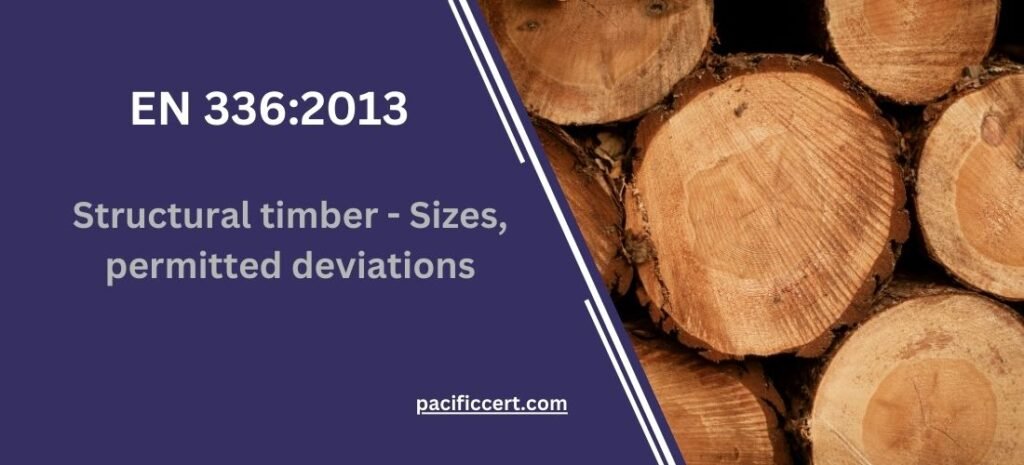
What is EN 336:2013 – Structural timber – Sizes, permitted deviations?
EN 336:2013 sets out the sizes and permitted deviations for structural timber used in construction. It specifies the dimensions and tolerances for sawn, planed, and machine-gauged softwood and hardwood timber, which is intended for structural use. Such as load-bearing applications in buildings and other structures.
The standard defines the nominal sizes for timber in both metric and imperial units. Including thickness, width, and length, and also provides tolerances for deviations from these nominal sizes. It also includes requirements for moisture content, surface quality, and other characteristics that can affect the performance and durability of the timber.
This standard is intended to help ensure consistency in the sizes and quality of structural timber used in construction, which can improve the safety and reliability of buildings and other structures. It is applicable to timber sourced from both native and non-native species. And is widely used throughout Europe as a reference for structural timber sizing and quality.
Requirements of EN 336:2013
Nominal sizes: The standard specifies nominal sizes for sawn, planed, and machine-gauged softwood and hardwood timber. The nominal sizes include thickness, width, and length.
Tolerances: EN 336 provides tolerances for deviations from the nominal sizes for both softwood and hardwood timber. The tolerances cover both individual dimensions and overall size, and they vary depending on the nominal size. And whether the timber is sawn, planed, or machine-gauged.
Moisture content: The standard sets out requirements for the moisture content of structural timber, which should be measured using an appropriate method. The maximum allowable moisture content depends on the type of timber and its use.
Surface quality: EN 336:2013 specifies requirements for the surface quality of structural timber. The standard defines four grades of surface quality, ranging from grade A (high-quality appearance) to grade D (rough sawn).
Other characteristics: The standard also includes requirements for other characteristics that can affect the performance and durability of structural timber. Such as density, strength, and stiffness.
This standard is intended to help ensure consistency in the sizes and quality of structural timber used in construction. Which can improve the safety and reliability of buildings and other structures.
Benefits of EN 336:2013 – Structural timber – Sizes, permitted deviations
Consistency: The standard provides clear guidelines for the nominal sizes and permitted deviations of structural timber, which helps ensure consistency and accuracy in the sizing of timber used in construction projects. This consistency can lead to improved safety and reliability of buildings and other structures.
Quality control: The tolerances and surface quality requirements set out in EN 336:2013 can help ensure that structural timber meets certain quality standards. This can help prevent defects and ensure that the timber is suitable for its intended use.
Compatibility: EN 336 specifies sizes and tolerances for both softwood and hardwood timber. Making it easier to compare and use different types of timber in construction projects. This can help improve compatibility and reduce waste.
Moisture content: By setting maximum allowable moisture content levels, EN 336:2013 helps ensure that structural timber is appropriately seasoned and reduces the risk of warping, splitting, or other damage caused by excessive moisture.
Ease of use: The standard provides clear guidelines and specifications that can help simplify the process of selecting, sizing, and working with structural timber. This can save time and effort during the construction process.
Who needs EN 336:2013 – Structural timber – Sizes, permitted deviations?
EN 336:2013 applies to all structural timber used in construction projects, including softwood and hardwood. It is relevant for manufacturers, designers, and builders of timber structures. As well as architects, engineers, and other professionals involved in the construction industry.
The standard provides guidelines for the sizes and permitted deviations of structural timber, which can help ensure consistency, quality, and safety in construction projects. Additionally, it may be used by regulators and building code officials to help enforce standards for the use of timber in construction.
Pacific Certifications is accredited by ABIS, if you need more support with EN 336:2013, please contact us at +91-8595603096 or support@pacificcert.com
Read About: EN 301:2023









